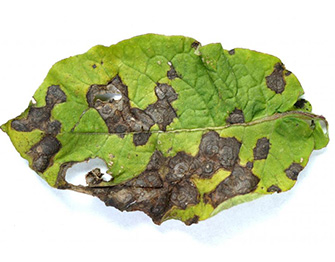Please click here to access the main AHDB website and other sectors.
- Home
- Knowledge library
- Alternaria
Alternaria
Alternaria, also known as early blight, is a mainly soil-borne fungal pathogen that affects potato crops. It is a global disease that has been present in GB crops for many years. Warm and wet periods favour the disease, and if not controlled, it can cause dramatic leaf loss, leading to yield reductions of up to 30%. There are differences in varietal susceptibility.
The predominant species is Alternaria solani. Another species that affects potatoes and tends to infect later in the season is Alternaria alternata. It is almost impossible to distinguish the two species without a microscope.
Symptoms
Alternaria causes lesions on the leaves which often have a target spot appearance of concentric rings. These usually (but not always) appear a few weeks after emergence and start as very small black or brown spots on lower leaves which then coalesce. This causes the leaf tissue to die as the disease spreads thus the symptoms will appear different as the disease progresses. The disease is distinct from late blight (Phytophthora infestans) as Alternaria spores on the leaves cannot be seen, even with a hand lens, and there is no distinctive milky ring of sporulation around the lesion on the underside of the leaf.
Diagnosis can be problematic as symptoms can be mistaken for nutrient deficiency or Verticillium wilt. In particular symptoms are often confused with magnesium deficiency and manganese toxicity.
Conditions
Alternaria does not spread as far or as wide as late blight. The fungus survives between crops on potato or other host debris or directly in the soil as spores. These can then infect potato leaf tissue as the crop develops. Spores can be transferred on seed or via cultivation equipment, although this is not its primary method of spread.
Lower leaves of the growing crop pick up spores from the soil, while later season infections from rain splash or wind-blown spores can be spread around the plant. Periods of wet and dry will favour Alternaria’s life cycle and encourage spore germination and release. This means conditions in irrigated crops are ideal for disease development. It will thrive under the crop canopy. Making regular crop inspections is important.
Control
Cultural methods of control are limited, but controlling debris in the field will help. Good weed management, removing volunteers and alternative hosts such as nightshade, will also reduce levels of Alternaria. Long crop rotations can limit disease incidence.
The impact will also be lessened if you don’t let your crop become stressed. Good crop management, appropriate fertiliser applications and irrigation best practice reduces disease impact.
The most important factor when deciding your fungicide strategy remains effective control of late blight. Decide product choice, dose rate and interval to ensure you have a robust strategy in place.


